R.E. Kearney's Blog, page 3
November 28, 2024
Effects of Space Travel on the Human Body
In my science-based fiction, Mars Madness, I described how living and working in space is a remarkable experience, but that it comes with unique challenges that affect an astronaut’s body in profound ways, particularly those who take part in long-duration space missions. Space is a harsh environment, and the absence of gravity, exposure to radiation, and isolation can lead to significant physiological and psychological changes.
Microgravity and Musculoskeletal Health

One of the most significant changes astronauts experience in space is microgravity. In the microgravity environment of space, the muscles and bones no longer need to support the body’s weight, leading to muscle atrophy and bone density loss. Studies show that astronauts can lose up to 20% of their muscle mass and 1-2% of their bone density per month.
To counteract these effects, astronauts follow rigorous exercise regimens while aboard the International Space Station (ISS). They use specially designed equipment, such as resistance machines and treadmills, to maintain muscle mass and bone density. Despite these measures, some degree of muscle and bone loss is inevitable, and recovery can take months after returning to Earth.
Cardiovascular Changes
In the absence of gravity, bodily fluids shift toward the upper body and head, causing a condition known as “fluid shift.” This shift can lead to facial puffiness and increased intracranial pressure. Additionally, the heart, which no longer has to work as hard to pump blood against gravity, can undergo changes in size and function.
Astronauts often experience orthostatic intolerance, a difficulty in standing upright without feeling faint, upon returning to Earth. This is due to the deconditioning of the cardiovascular system. Exercise and careful monitoring of fluid intake and blood pressure are essential to mitigate these effects.
Vision Impairment
A significant proportion of astronauts develop vision problems during long-duration missions, a condition known as Spaceflight-Associated Neuro-ocular Syndrome (SANS). Fluid shifts and increased intracranial pressure are thought to contribute to this syndrome, which can cause changes in the shape of the eyeball and optic nerve swelling. Researchers are actively investigating ways to prevent and treat these vision changes.
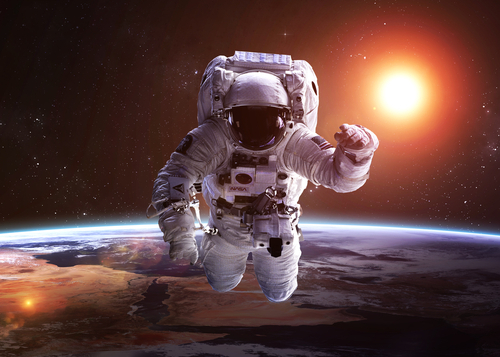
Radiation Exposure
Outside the protective shield of Earth’s atmosphere, astronauts are exposed to higher levels of cosmic radiation. This radiation can damage cells and increase the risk of cancer and other diseases. Prolonged exposure to radiation in space is one of the major concerns for missions to Mars and beyond.
To limit radiation exposure, spacecraft and habitats are designed with shielding materials. Additionally, mission planners carefully monitor solar activity and adjust schedules to minimize exposure during periods of high radiation.
Psychological Effects
The psychological challenges of living in space include isolation, confinement, and the absence of familiar social support networks. Astronauts must adapt to living in a small, enclosed environment with limited privacy and direct contact with friends and family.
NASA and other space agencies provide astronauts with psychological support, including regular communication with loved ones, access to counseling services, and recreational activities. Team cohesion and mental health are critical for mission success, and astronauts undergo extensive training to prepare for these challenges.
The effects of space travel on the human body are profound and multifaceted. While microgravity, radiation, and isolation present significant challenges, ongoing research and technological advancements continue to improve our understanding and mitigation of these effects. As humanity pushes the boundaries of space exploration, the lessons learned from current missions will pave the way for future journeys to Mars and beyond. The resilience and adaptability of the human body, coupled with the ingenuity of science and technology, will enable us to thrive in the final frontier.
November 14, 2024
Interstellar Tunnels
The concept of interstellar tunnels, also known as wormholes, has captured the imagination of scientists, writers, and dreamers alike. These hypothetical passages through space-time offer a tantalizing possibility: the ability to travel vast cosmic distances in a fraction of the time it would take using conventional means.
The Science of Wormholes
The idea of wormholes originates from the field of general relativity, which describes how gravity affects the fabric of space-time. In 1935, physicists Albert Einstein and Nathan Rosen proposed the existence of “Einstein-Rosen bridges,” which we now refer to as wormholes. These theoretical structures are like tunnels connecting two separate points in space-time, potentially allowing for rapid travel between distant regions of the universe.

Mathematically, wormholes can be described by solutions to the equations of general relativity. The most famous type is the Schwarzschild wormhole, also known as the Einstein-Rosen bridge. Another well-known example is the traversable wormhole, which was further developed in theoretical models by physicists Kip Thorne and Michael Morris. Unlike black holes, which are characterized by their event horizons and singularities, traversable wormholes would allow passage without being torn apart by extreme gravitational forces.
The Challenges
Despite the intriguing theoretical foundation, there are significant challenges to the existence and practical use of wormholes. One major issue is stability. Most solutions to the equations of general relativity suggest that wormholes would require “exotic matter” with negative energy density to remain open. This exotic matter is hypothetical and has not been observed in nature. Without it, a wormhole would likely collapse quickly, rendering it unusable.
Additionally, the creation and maintenance of a wormhole would require immense amounts of energy. The technology to harness such energy is far beyond our current capabilities. Even if we could generate this energy, the risk of unknown consequences, such as destabilizing space-time or causing catastrophic events, cannot be ignored.
Implications for Space Travel
If wormholes could be created and stabilized, they would revolutionize space travel. The distances between stars, which are currently measured in light-years, could be traversed almost instantaneously. This would open up new possibilities for exploration, colonization, and communication. Instead of taking thousands of years to reach a neighboring star system, humans could travel to distant galaxies in a single leap.

Wormholes in Popular Culture
Wormholes have been a staple of science fiction for decades, appearing in countless books, movies, and TV shows. They provide a convenient plot device for overcoming the vast distances of space. In the movie “Interstellar,” directed by Christopher Nolan, wormholes play a central role in humanity’s search for a new habitable planet. The depiction of wormholes in this film was grounded in scientific theories, with input from physicist Kip Thorne to ensure accuracy.
Another classic example is the Stargate franchise, where wormholes created by ancient devices called Stargates allow instant travel between different planets. These portrayals capture the sense of wonder and possibility that wormholes evoke, even if the science behind them remains speculative.
Conclusion
Interstellar tunnels, or wormholes, represent one of the most captivating ideas in theoretical physics. While they remain firmly in the realm of hypothesis, their potential to revolutionize our understanding of space travel continues to inspire. As our knowledge of the universe grows and technology advances, the dream of traversing the cosmos through these enigmatic tunnels might one day become a reality. Until then, wormholes will remain a fascinating subject for scientific inquiry and imaginative storytelling.
October 24, 2024
Life Around Underwater Thermal Vents
Deep beneath the ocean’s surface, where sunlight fails to penetrate and temperatures can reach extreme highs, underwater thermal vents create a unique and thriving ecosystem. These vents, also known as hydrothermal vents, are formed by tectonic activity that allows superheated water to escape from the Earth’s interior. While they may seem inhospitable at first glance, the life that exists around these vents is both diverse and fascinating, showcasing the resilience of life in extreme conditions.
The Environment of Hydrothermal Vents

Hydrothermal vents are typically found along mid-ocean ridges, where tectonic plates diverge. As seawater seeps into the ocean floor, it is heated by underlying magma before rising back up through cracks in the Earth’s crust. This process not only releases nutrient-rich water but also minerals, such as sulfides and methane, which are essential for supporting life in this dark, high-pressure environment.
The temperatures around these vents can soar to 400°C (752°F), and the water can be highly acidic and rich in toxic chemicals. However, rather than deterring life, these conditions have led to the development of a unique ecosystem that relies on chemosynthesis instead of photosynthesis.
Chemosynthetic Life Forms
At the heart of this ecosystem are chemosynthetic bacteria, which utilize the chemicals released by the vents to produce energy. Unlike plants that convert sunlight into energy, these bacteria thrive in darkness, using hydrogen sulfide and other compounds as their energy source. They form the foundation of the food web around hydrothermal vents.
These bacteria are often found in large colonies, providing food for a variety of organisms. One of the most iconic vent-dwelling species is the giant tube worm (Riftia pachyptila), which can grow up to 3 meters (10 feet) long. These worms harbor symbiotic bacteria in their bodies, which convert the vent chemicals into organic matter, allowing the worms to thrive in an otherwise nutrient-poor environment.
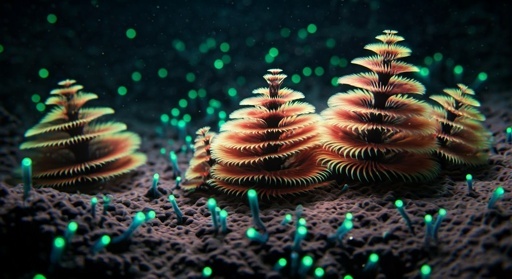
Diverse Marine Life
In addition to tube worms, hydrothermal vents host a rich diversity of life, including clams, mussels, and shrimp, many of which also rely on chemosynthetic bacteria for nourishment. For instance, species like the vent snail (Alviniconcha) have adapted to utilize the bacteria directly by forming symbiotic relationships. Crustaceans, such as the vent crab (Bythograea), are also commonly found, feeding on both the bacteria and other organisms.
Furthermore, vent ecosystems are often home to unique species that have evolved specific adaptations to their extreme environment. Some organisms possess specialized proteins that allow them to withstand high temperatures and pressure, while others have developed unique physical traits, such as thick shells or modified appendages for feeding.
The Importance of Hydrothermal Vents
Beyond their role as a fascinating biological hotspot, hydrothermal vents have significant implications for our understanding of life on Earth and potentially other planets. The extreme conditions in which these organisms thrive challenge traditional notions of where life can exist. Studying these ecosystems not only sheds light on evolutionary processes but also informs us about the potential for life in similar environments on celestial bodies like Europa or Enceladus, moons of Jupiter and Saturn, respectively.
In conclusion, underwater thermal vents are a testament to the adaptability and resilience of life. The intricate relationships formed between organisms in these extreme environments highlight the complexity of ecological systems and the importance of protecting these unique habitats from human activities, such as deep-sea mining and climate change. As scientists continue to explore these mysterious regions, they unlock more secrets about life’s potential and the Earth’s geological processes.
October 10, 2024
Solar Flares and Their Effects
Solar flares are among the most powerful and fascinating phenomena in our solar system. These intense bursts of radiation originate from the Sun and can have significant effects on Earth and its technological systems. Understanding solar flares is crucial for both scientific research and practical applications, as their impacts can range from beautiful auroras to disruptions in communication and power systems.
What Are Solar Flares?
Solar flares are sudden, intense bursts of electromagnetic radiation emanating from the Sun’s surface. They occur when magnetic energy that has built up in the solar atmosphere is suddenly released. This energy release can be so powerful that it emits radiation across the entire electromagnetic spectrum, from radio waves to gamma rays. The most intense solar flares are classified as X-class flares, followed by M-, C-, and B-class flares, with A-class being the smallest.

Causes of Solar Flares
The Sun’s surface is a dynamic and turbulent environment, primarily due to its magnetic field. Magnetic fields are generated by the movement of electrically charged gases within the Sun. These fields can become twisted and tangled due to the Sun’s rotation and convective motions. When the magnetic field lines near sunspots (regions of intense magnetic activity) become too twisted, they can snap and reconnect in a process known as magnetic reconnection. This process releases a tremendous amount of energy, resulting in a solar flare.
Effects on Earth
When solar flares are directed towards Earth, they can have several notable effects:
Geomagnetic Storms: Solar flares can interact with Earth’s magnetosphere, causing geomagnetic storms. These storms can disrupt satellite operations, GPS navigation, and radio communications. In severe cases, they can even affect power grids, leading to widespread outages.Auroras: One of the most visually stunning effects of solar flares is the aurora borealis (northern lights) and aurora australis (southern lights). These occur when charged particles from the Sun collide with Earth’s atmosphere, causing the atmosphere to glow in beautiful colors.Radiation Hazards: Solar flares emit high-energy particles that can pose a risk to astronauts and high-altitude flights. The Earth’s atmosphere and magnetic field provide significant protection, but during intense solar activity, additional precautions may be necessary.Impact on Technology: Solar flares can induce electric currents in power lines, potentially damaging transformers and other electrical infrastructure. They can also affect the accuracy of satellite-based navigation systems and disrupt high-frequency radio communications.
Mitigation and Monitoring
To mitigate the effects of solar flares, scientists continuously monitor solar activity using a variety of space-based and ground-based instruments. Agencies like NASA and the National Oceanic and Atmospheric Administration (NOAA) provide forecasts and warnings of solar storms, allowing for preventive measures to be taken. For example, power companies can temporarily shut down vulnerable systems, and airlines can reroute flights to avoid high-radiation areas.
Conclusion
Solar flares are a testament to the dynamic and powerful nature of our Sun. While they can pose challenges to our technological infrastructure, they also offer opportunities for scientific discovery and awe-inspiring natural displays. By understanding and monitoring solar flares, we can better prepare for their impacts and continue to marvel at the wonders of our solar system.
September 26, 2024
The Big Bang Theory: What It Is and How It Might Not Be True
The Big Bang Theory is the prevailing cosmological model explaining the origin and evolution of the universe. According to this theory, the universe began approximately 13.8 billion years ago from an extremely hot and dense singularity, which then expanded and continues to expand today. The theory was first proposed by Belgian priest and physicist Georges Lemaître in the 1920s and has since been refined with contributions from various scientists.
One of the most compelling pieces of evidence for the Big Bang Theory is the cosmic microwave background radiation (CMB). Discovered in 1965 by Arno Penzias and Robert Wilson, the CMB is the afterglow of the initial explosion, now cooled to just a few degrees above absolute zero. This radiation is remarkably uniform, supporting the idea that the universe began from a hot, dense state.

Another supporting observation is the redshift of galaxies. Edwin Hubble’s observations in the 1920s showed that galaxies are moving away from us, with more distant galaxies moving faster. This redshift is interpreted as evidence of an expanding universe, consistent with the Big Bang model.
How Might the Big Bang Theory Not Be True?
Despite its widespread acceptance, the Big Bang Theory is not without its challenges and alternative explanations. One of the main criticisms is the horizon problem. The CMB is uniform in all directions, but regions of the universe that are far apart have not had enough time to exchange information or energy, given the speed of light. This uniformity is difficult to explain under the standard Big Bang model.
Another issue is the flatness problem. The universe appears to be very close to geometrically flat, meaning its overall density is very close to the critical density. Small deviations from this critical density would have led to a vastly different universe, either collapsing back on itself or expanding too rapidly for galaxies to form. The Big Bang Theory does not naturally explain why the universe’s density is so finely tuned.
To address these issues, the theory of cosmic inflation was proposed by Alan Guth in the 1980s. This theory suggests a rapid exponential expansion of the universe in the first fractions of a second after the Big Bang, smoothing out any irregularities and explaining the uniformity of the CMB and the flatness of the universe. However, inflation itself is a hypothesis that has yet to be directly observed.
There are also alternative models to the Big Bang. One such model is the Steady State Theory, which posits that the universe has no beginning or end and is in a constant state of creation. Although this theory has fallen out of favor due to lack of supporting evidence, it highlights that our understanding of the universe’s origins is still evolving.

Recently, Lior Shamir, an associate professor of computer science at Kansas State University, has revived the “Tired Light” theory to challenge the widely accepted Big Bang Theory. This theory, originally proposed by Fritz Zwicky in 1929, suggests that the redshift observed in distant galaxies is not due to the expansion of the universe but rather because light photons lose energy as they travel through space.
Shamir’s research, supported by observations from the James Webb Space Telescope (JWST), indicates that the universe might not be expanding as previously thought. Instead of showing an early, infant universe, the JWST has revealed large and mature galaxies, which contradicts the expected timeline if the Big Bang had occurred. According to Shamir, this discrepancy suggests that the galaxies are older than the universe itself, challenging the Big Bang model.
Shamir’s findings also show that the redshift of galaxies changes with their distance from Earth, aligning with the Tired Light theory. This theory posits that as light travels over vast distances, it loses energy, leading to the observed redshift without requiring an expanding universe.
While Shamir’s work has sparked interest and debate, it remains controversial but highlights the ongoing quest to understand the universe’s origins and the need to continually reassess our scientific models in light of new evidence.
September 12, 2024
Are Smartphones Listening to Our Conversations?
In recent years, many people have reported eerie experiences where they discuss a product or service, only to see related ads pop up on their smartphones shortly after. This phenomenon has led to widespread speculation that smartphones might be eavesdropping on conversations to generate tailored advertisements. But is there any truth to these claims?
The Technology Behind Targeted Ads
To understand the debate, it’s essential to grasp how targeted advertising works. Companies like Google and Facebook collect vast amounts of data about users’ online behavior, including search history, browsing patterns, and app usage. This data is then analyzed using advanced algorithms and machine learning techniques to create detailed user profiles. These profiles help advertisers deliver highly personalized ads based on inferred interests and preferences.
Benefits of Behavioral Advertising
 Relevance: Ads are more relevant to users’ interests, making them more likely to engage with the content.Efficiency: Advertisers can allocate their budgets more effectively by targeting specific user segments.Higher Conversion Rates: Personalized ads tend to have higher conversion rates compared to generic ads.
Relevance: Ads are more relevant to users’ interests, making them more likely to engage with the content.Efficiency: Advertisers can allocate their budgets more effectively by targeting specific user segments.Higher Conversion Rates: Personalized ads tend to have higher conversion rates compared to generic ads.While behavioral advertising offers many benefits, it also raises significant privacy concerns. The extensive data collection required for this type of advertising can feel intrusive to users. Many people are unaware of the extent to which their data is being tracked and used. To address privacy concerns, regulations like the General Data Protection Regulation (GDPR) in Europe and the California Consumer Privacy Act (CCPA) in the United States have been implemented. These laws require companies to be transparent about their data collection practices and give users more control over their personal information.
The Eavesdropping Allegations
Despite the sophisticated data collection methods, many users believe that their smartphones are listening to their conversations. Anecdotal evidence abounds: people discuss a product with friends, and soon after, they see ads for that very product. This has fueled the suspicion that apps are using smartphone microphones to gather information for targeted ads.
What Companies Say
Major tech companies, including Facebook and Google, have consistently denied these allegations. They assert that while their devices do listen for “wake words” like “Hey Siri” or “OK Google,” they do not monitor conversations for advertising purposes. Facebook, for instance, has stated that it only accesses the microphone when users explicitly allow it, such as when recording a video.

The Role of Behavioral Advertising
Experts argue that the perceived eavesdropping can be explained by behavioral advertising. This practice involves collecting data from various sources, such as browsing history, location, and social media activity, to predict user interests. For example, if you frequently search for travel destinations, you might start seeing ads for hotels and flights, even if you haven’t discussed your travel plans aloud.
Research Findings
Recent research has added fuel to the fire. Studies have shown that mobile devices can indeed listen to conversations through microphones and create personalized ads based on what is heard. However, these findings are controversial and have not been universally accepted. The debate continues, with some experts insisting that the vast amounts of data collected through other means are sufficient for creating highly targeted ads without the need for eavesdropping.
Recently, Cox Media Group, who list Facebook, Google and Amazon as their clients, use highly intelligent “Active Listening” software that uses microphones to capture and analyze audio in real-time. This software can listen to conversations and other sounds, often leveraging artificial intelligence (AI) to process and interpret the data.
Privacy Concerns
Regardless of whether smartphones are listening to conversations, the broader issue of privacy remains a significant concern. The extensive data collection practices of tech companies have raised ethical questions about user consent and data security.
Conclusion
While the idea of smartphones eavesdropping on conversations to generate tailored ads is compelling, there is no concrete evidence to support this claim. Tech companies deny the practice, and experts suggest that behavioral advertising can explain the uncanny accuracy of targeted ads. However, the debate highlights the need for greater transparency and stricter privacy regulations to protect users in the digital age.
August 29, 2024
Growing Plants in Space
As humans venture into space, the need to sustain life becomes paramount. Fresh produce is essential for astronauts’ health during long-duration missions, but resupply shipments won’t suffice for deep space exploration. Enter astrobotany—the study of plant growth in space environments. Here’s what we’ve learned so far:
In space, plants face unique stressors like microgravity, ionizing radiation, and oxidative stress. These stressors can cause genetic alterations in plant metabolism pathways. Researchers aim to understand how plants adapt and thrive under these conditions.
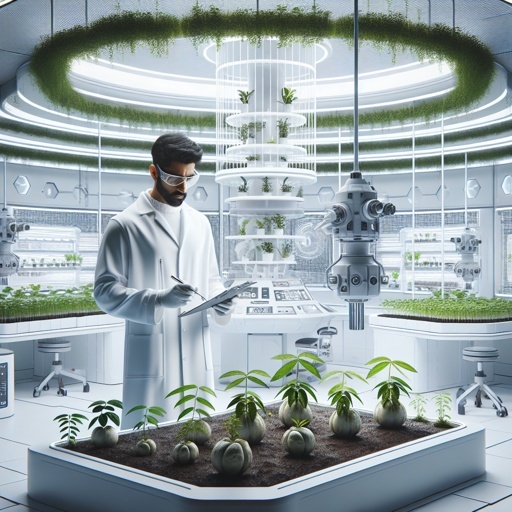
NASA’s Vegetable Production System (Veggie) is a space garden on the International Space Station (ISS). Veggie helps study plant growth in microgravity while providing fresh food for astronauts. Microgravity affects water distribution, root development, and nutrient uptake. The garden, about the size of carry-on luggage, typically holds six plants. Each plant grows in a “pillow” filled with clay-based growth media and fertilizer. LEDs above the plants emit a spectrum of light suited for growth, resulting in a magenta pink glow.
Astronauts have successfully grown lettuce, radishes, and tomatoes in Veggie. These crops provide essential nutrients and contribute to psychological well-being.
Veggie’s success encourages the development of more advanced space gardens. Self-sufficiency in food production will be crucial for long-duration missions. Future missions may involve more advanced space gardens, allowing self-sufficiency. The challenge remains: How do we cultivate fresh produce in a closed environment without sunlight or Earth’s gravity?
Plants on Mars: Challenges and Possibilities
In my book, Mars Madness, I introduced the idea of how fungi could be grown on Mars to support life. In reality, growing plants on Mars is a fascinating endeavor, but it comes with significant challenges:
Martian Soil: Martian soil contains essential plant nutrients, but their levels are too low for healthy growth. Fertilizers would be necessary to enhance soil conditions for plants.
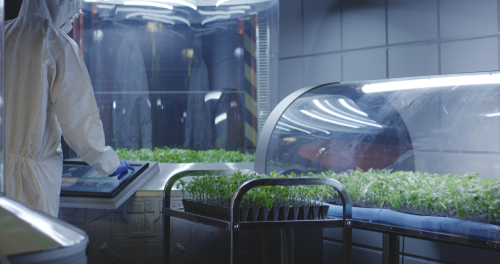
Harsh Environment: Mars has thin air, extreme cold, and sterilizing radiation. A Martian greenhouse would shield plants from direct exposure. During the day, plants would face high solar ultraviolet radiation due to the lack of ozone in the Martian atmosphere. Nighttime temperatures drop well below freezing.
Designer Plants: Scientists are genetically modifying plants to withstand Martian conditions. They splice genes from extremophiles (microscopic organisms that thrive in harsh environments on Earth) into plants. These modified plants could provide oxygen, food, and medicine for astronauts while recycling waste.
Current research focuses on demonstrating feasibility and identifying technical challenges. Martian plants won’t be a reality for at least a decade or more.
August 15, 2024
The Effects of Excessive iPad Exposure on Your Child’s Brain Development
With the rise of digital media, it’s easy to give in to children’s requests for more iPad time. However, it’s crucial to recognize that too much exposure to these devices can negatively impact a child’s brain development.
Recent studies shed light on the effects of screen time, particularly iPad usage, on children’s well-being:
 Obsessive-Compulsive Disorder (OCD) Risk: A study published in the Journal of Adolescent Health followed over 9,200 children aged 9 to 10 for two years. Researchers found that excessive screen time (including video games and videos) was associated with a higher risk of OCD diagnoses among preteens. Specifically, for every hour spent playing video games, the odds of developing OCD increased by 15%. Watching videos also contributed to this risk. Interestingly, texting, video chatting, and social media use were not linked to OCD risk in this cohort.Emotional Regulation and Social Issues: Another intriguing study highlighted that children as young as two years old, often referred to as “iPad kids,” may face long-term emotional and social problems. Excessive digital media consumption during early childhood could lead to emotional and social issues later in life.Physical Health Impacts: Spending too much time on iPads can lead to headaches, eye strain, and blurred vision. The blue light emitted from iPad screens disrupts the body’s circadian rhythm, potentially causing sleep disorders and related health problems. Excessive screen time disrupts the body’s circadian rhythm, leading to sleep disorders. Concerns exist about radiation emitted by these gadgets, which could pose potential health risks over time. Extended iPad use contributes to sedentary behavior, leading to obesity and other health issues due to a lack of physical activity.Behavioral Changes: Constant stimulation and instant gratification from the device can make it difficult for children to concentrate on other activities, affecting learning environments. Solitary iPad use may hinder the development of necessary social skills, impacting friendships and relationships. Children can become addicted to their iPads, neglecting other activities and responsibilities.Creating Healthy Limits
Obsessive-Compulsive Disorder (OCD) Risk: A study published in the Journal of Adolescent Health followed over 9,200 children aged 9 to 10 for two years. Researchers found that excessive screen time (including video games and videos) was associated with a higher risk of OCD diagnoses among preteens. Specifically, for every hour spent playing video games, the odds of developing OCD increased by 15%. Watching videos also contributed to this risk. Interestingly, texting, video chatting, and social media use were not linked to OCD risk in this cohort.Emotional Regulation and Social Issues: Another intriguing study highlighted that children as young as two years old, often referred to as “iPad kids,” may face long-term emotional and social problems. Excessive digital media consumption during early childhood could lead to emotional and social issues later in life.Physical Health Impacts: Spending too much time on iPads can lead to headaches, eye strain, and blurred vision. The blue light emitted from iPad screens disrupts the body’s circadian rhythm, potentially causing sleep disorders and related health problems. Excessive screen time disrupts the body’s circadian rhythm, leading to sleep disorders. Concerns exist about radiation emitted by these gadgets, which could pose potential health risks over time. Extended iPad use contributes to sedentary behavior, leading to obesity and other health issues due to a lack of physical activity.Behavioral Changes: Constant stimulation and instant gratification from the device can make it difficult for children to concentrate on other activities, affecting learning environments. Solitary iPad use may hinder the development of necessary social skills, impacting friendships and relationships. Children can become addicted to their iPads, neglecting other activities and responsibilities.Creating Healthy Limits
As parents, we must ensure that our children engage in activities beneficial for their growth and development. Setting guidelines for iPad usage is essential to strike a balance between technology and well-being.
Technology can have several positive effects on children when used mindfully and in moderation.
Educational Apps and Learning Tools: Interactive educational apps and software can enhance learning experiences. Children can explore various subjects, practice math, learn languages, and develop critical thinking skills.Creativity and Expression: Technology allows children to express their creativity through digital art, music, and writing. Platforms like Scratch encourage coding and problem-solving.Access to Information: The internet provides a wealth of information. Children can research topics, learn about different cultures, and explore their interests.Communication and Social Skills: Video calls and messaging apps help children stay connected with family and friends. Online communities foster social interactions and collaboration.Health and Fitness Apps: Fitness trackers and health apps encourage physical activity and mindfulness. Yoga apps, step counters, and nutrition guides promote overall well-being.Remember, balance is key. Encourage healthy tech habits while reaping the benefits!
July 25, 2024
Brainoware: Merging Human Brain Tissue with Electronics
In recent years, scientists have embarked on a groundbreaking endeavor: creating a computer that combines real human brain tissue with electronic components. This innovative technology, known as Brainoware, represents a remarkable convergence of biology and computing.
The Brain Organoid Connection
At the heart of Brainoware lies a tiny brain-like structure called a brain organoid. These mini-brains are cultivated from human stem cells in laboratory settings. Unlike traditional silicon-based computers, Brainoware taps into the inherent efficiency of living brain cells.

Wetware Computing: A New Paradigm
Brainoware operates through a concept known as wetware computing. Researchers house 16 brain organoids within four arrays, each connected to eight electrodes. A microfluidics system supplies water and nutrients to these clusters of lab-grown brain cells.
Energy Efficiency and Potential Impact
The energy consumption of Brainoware is remarkably low compared to digital processors. While we lack specific numbers for this system, consider that training large language models like GPT-3 (a precursor to GPT-4) requires an astounding 10 gigawatt hours—equivalent to 6,000 times the energy used by a European citizen in a year. In contrast, the human brain, with its 86 billion neurons, operates on a mere 0.3 kilowatt hours per day.
A Sustainable Alternative
As the AI industry continues to expand, energy-efficient computing becomes crucial. Brainoware offers a promising alternative, bridging the gap between biological networks and electronic circuits. By harnessing the power of human brain cells, we may unlock new frontiers in computing while minimizing our environmental impact.
Ethical implications
The ethical implications of Brainoware are multifaceted and thought-provoking.
Autonomy and Consent: Brainoware involves manipulating human brain tissue, which raises questions about informed consent. If we use brain organoids from donors or patients, ensuring their autonomy and consent becomes crucial. Additionally, should we grant these brain organoids any form of agency or rights? Striking a balance between scientific progress and ethical boundaries is essential.
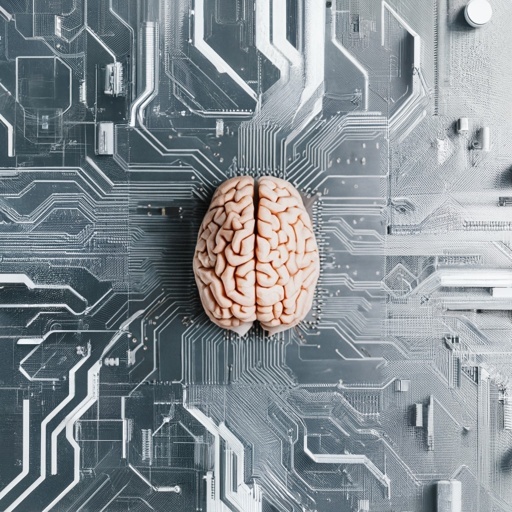
Identity and Personhood: When we merge biological brain cells with electronics, we blur the lines between human and machine. Defining personhood in this context becomes challenging. Does Brainoware possess consciousness or self-awareness? If so, how do we respect its rights?
Privacy and Data Security: Brainoware could process sensitive information directly from neural networks. Protecting privacy and preventing unauthorized access to these hybrid systems is critical. Imagine a scenario where Brainoware interfaces with personal memories—how do we safeguard against misuse?
Unintended Consequences: Brainoware’s behavior might be unpredictable due to the complexity of brain tissue. Unexpected emergent properties could arise. Ensuring safety and minimizing unintended consequences is paramount.
Equity and Access: Brainoware could exacerbate existing inequalities. Will it be accessible only to the privileged few? We must consider equitable distribution, affordability, and accessibility.
Dual-Use Dilemma: Brainoware could have both beneficial and harmful applications. Dual-use technology presents challenges. How do we prevent malicious uses, such as brain-controlled weaponry or invasive surveillance?
Long-Term Effects: Brainoware’s impact on human health remains uncertain. Could it lead to unforeseen health issues? Rigorous testing and ongoing monitoring are essential.
In summary, Brainoware represents a bold leap toward a future where living brain tissue collaborates with technology, ushering in a new era of sustainable computing but a delicate balance between scientific advancement and responsible stewardship is needed.
July 11, 2024
Tattoos and Lymphoma Risk
Tattoo ink is a fascinating blend of chemistry and artistry. While the exact composition can vary among manufacturers, most tattoo inks consist of the following basic components:

Pigments: These are the colorants that give tattoos their distinct hues. Pigments can be organic or inorganic compounds, and they come in various shades.
Carriers: Carriers are liquids that help suspend the pigments and facilitate their application into the skin. Common carrier fluids include glycerin, distilled water, isopropyl alcohol, or witch hazel.
Additives: These substances enhance specific properties of the ink, such as ink flow, color consistency, and shelf life. Some inks may contain additives like propylene glycol or even antibiotics.
It’s essential to note that tattoo inks can sometimes contain unlisted or potentially harmful ingredients and the pigments can also cause allergic reactions.

More worryingly, a recent study conducted by researchers at Lund University in Sweden investigated whether having tattoos might increase the risk of malignant lymphoma, a rare form of cancer that affects white blood cells (lymphocytes).
The study included 5,591 people diagnosed with lymphoma between 2007 and 2017. They found that tattooed individuals had a 21% higher risk of lymphoma compared to those without tattoos, even after accounting for smoking and education levels.
Lymphoma, also known as lymphatic cancer, is a type of blood cancer that affects white blood cells called lymphocytes. It originates in the lymphatic system, which includes lymph nodes, the spleen, thymus, tonsils, and bone marrow. Common symptoms of lymphoma include swollen lymph nodes, fever, night sweats, fatigue, itchy skin, and unexplained weight loss.
It’s essential to note that lymphoma is a very rare disease, and the risk increase is relative to a low baseline risk.
Interestingly, the size of the tattoos did not significantly impact the risk. However, the duration of having tattoos mattered: new tattoos (received within two years) and older tattoos (received over ten years ago) showed a higher risk.
It is believed that when the chemicals contained in Tattoo inks are injected into the skin, the body perceives it as foreign material. As a result, an immune response occurs, leading to ink particles ending up in the lymph nodes.
However, there’s no definitive evidence directly linking tattoos to skin cancer. While some studies suggest a possible association, it remains inconclusive.



